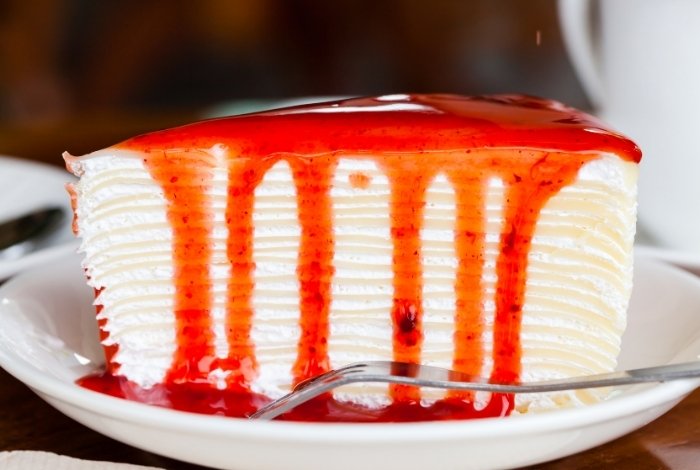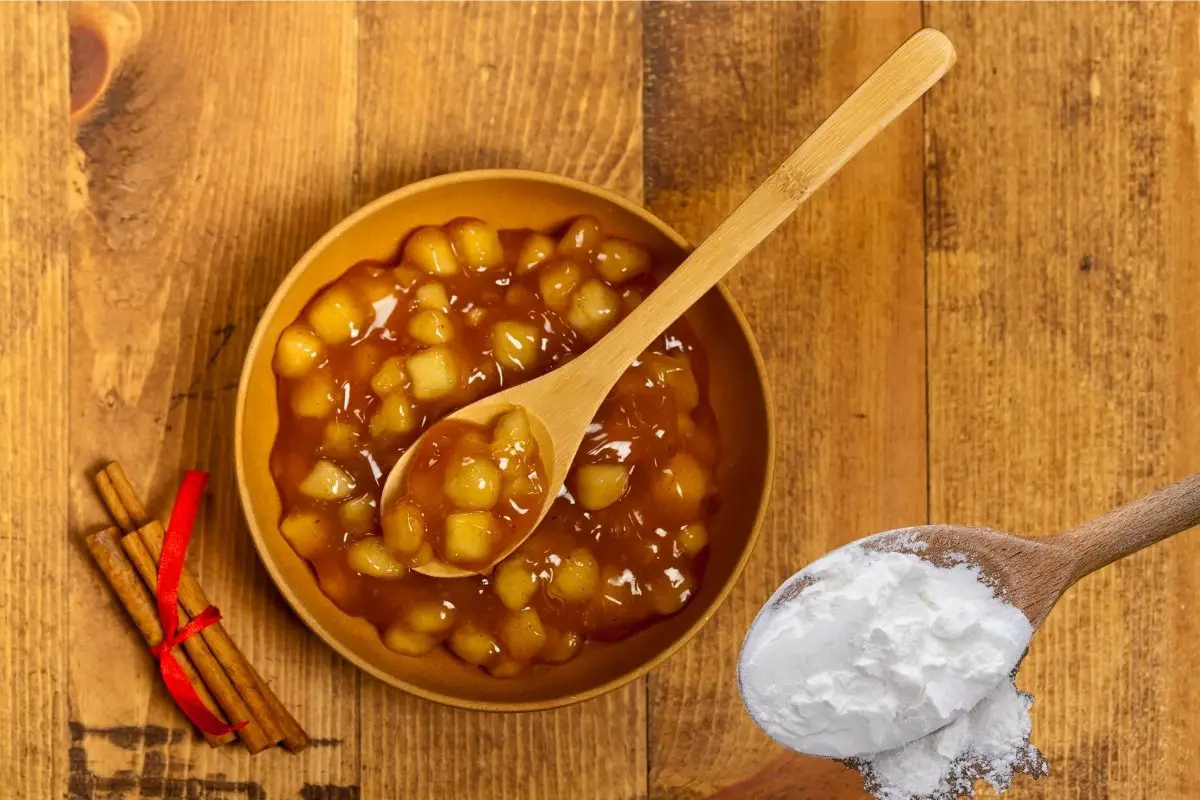Last Updated on January 14, 2023
Which pie thickener is best to achieve that delicious and sliceable filling? Rich, creamy, and smooth? Whatever your preference is, it eventually relies on the pie thickener you are using, cornstarch vs. flour. However, how would you know for sure when to use the right pie thickener in your pies, or, more specifically, can you substitute cornstarch for flour in apple pie? And what makes cornstarch different from flour? Take a look at this article and find out!
Pie Thickeners: Cornstarch vs. Flour
Both cornstarch and flour are grain starches since they need to be boiled for several minutes, ensuring that they are cooked well. Both are best used with cream pies where pastry cream is a base when making pie. Lumpy, pasty, or gluey are not great qualities of a delicious and delicate gel-like filling for your fruit pie. The kind of starch you are using is essential when thickening your fruit pie since choosing the right grain starch provides a better structure and holds it together well.

Difference between Cornstarch and Flour
Cornstarch and flour are two very distinct culinary and baking components. One of the primary distinctions between the two is the type of grain they are made from. In a nutshell, cornstarch is made from corn, whereas flour is made from wheat or other common grains such as rye, barley, and oats.
Another difference between the two is the texture. Cornstarch has a considerably finer and smoother texture than flour, which gives it a different mouthfeel. Frankly, this is a key consideration when choosing which of these components will do better in certain recipes. Furthermore, flour is more versatile and can be used in a wide variety of recipes, while cornstarch, on the other hand, is primarily intended to be used as a thickening agent.
After all, the biggest difference between them is that flour is a key ingredient in many bakery products. At the same time, cornstarch is usually not used in baking, but, as we already mentioned, as a thickener.
How Do They Work?
Pie thickeners work similarly. The starches in the thickeners are heated, which causes the bond between the pie filling and the liquids. As a result, it starts to swell, making a more stable structure to the pie filling. This process is the main reason why the pie filling does not get thick until it is cooked. The appearance, flavor, and temperature at which they start to thicken, including how long they can hold their structure after cooking, is what differentiates them as pie thickeners.
The best thing to do is to know the exact quantity of thickness you want with your pie since cornstarch and flour have their own advantages and disadvantages as pie thickeners.
Oster French Convection Countertop and Toaster Oven
What Makes Cornstarch Better Than Flour?
Cornstarch is a faster thickening agent than flour because it does not require too much cooking time. It results in a clear and smooth filling that is starchy and silky. Cornstarch is made by soaking, milling, grounding, sieving, and centrifuging corn. Hence, sugar helps the cornstarch separate better when it is mixed with liquids. However, it needs high temperatures to activate and has a chalky texture and flavor when used too much or undercooked. Likewise, it loses its thickening power if over-whisked since it is moderately stable.
Though it is clearer than flour, fruit pie fillings thickened with cornstarch will appear opaque. Another thing to consider is that cornstarch cannot be mixed with acidic liquids. Also, it cannot be frozen because it transforms into a watery mixture when thawed. As a result, cornstarch should be mixed with an equivalent amount of cold water and stirred gently into the hot fruit pie filling at the end of baking.
Why is it Better to Use Cornstarch vs. Flour? And What are its Downsides?
On the contrary, flour works best with less juicy fruits like apples since it is a natural thickening agent. As a result, it produces a wheat-flavored taste and a lightly gummy texture with a cloudy filling. Also, it thickens at low temperatures. Likewise, flour is remarkably stable and can last longer than cornstarch in prolonged baking. That is why it is an all-purpose thickener.

It is ideal to use flour in achieving a cloudy finish compared to cornstarch. Although, use twice as much flour as cornstarch as a general rule of thumb. Also, it provides pies with a matte appearance that suits well with apple pies and pear pies but not so much for summer berry pies. Flour is not the best thickener because it is not pure starch.
Can You Substitute Flour for Cornstarch in Pie Filling?
Yes, it is possible to substitute flour for cornstarch in pie filling, and these are some of the reasons people choose to do so:
- They don’t have cornstarch on hand and need to use some pantry staple like flour as a substitute.
- They are looking for a gluten-free alternative to cornstarch and choose to use gluten-free flour instead.
- They prefer the taste or texture of a pie filling made with flour to one made with cornstarch.
However, it is extremely important to note that it may not work as well as cornstarch. Namely, it is about the fact that cornstarch is much more effective in thickening liquids, compared to flour, and accordingly, you may need to use more flour to achieve the desired consistency. Additionally, if you use flour instead of cornstarch, your pie filling may have a slightly different texture and flavor.
In case you do decide to do it, here’s what you need to know:
- Mix equal parts flour and cold water to create a slurry. Here’s an example, if a recipe calls for 1 tablespoon of cornstarch, use 1 tablespoon of flour and 1 tablespoon of water to make a substitute for cornstarch in the pie filling.
- Stir in the flour slurry until fully incorporated with the pie-filling mixture.
- Bring the mixture to a boil and allow it to simmer for 1-2 minutes to thicken the filling. Be sure to let it cool before using it in your recipe.
That’s it, now you know the answer to the question: “can you substitute cornstarch for flour in apple pie” too.
How Much Cornstarch to Thicken Pie Filling?
Too thin a pie filling may not hold its shape when baked, resulting in a difficult-to-slice and-serve pie, and that’s something we would all like to avoid, right? What’s worst of all, a thin filling may not have enough body to support the weight of the pie crust, causing it to get soggy, mushy, or collapse. By thickening the filling, you can help it hold its shape and make it easy to cut and serve.
Let’s get back to the topic, the general rule of thumb is to use about 2 tablespoons of cornstarch per cup of liquid in the pie filling. Accordingly, if your pie filling has 3 cups of liquid, you would use about 6 tablespoons of cornstarch. Keep in mind that everything depends on the recipe and desired consistency to achieve, so sometimes you will have to use more or less than what the general rule suggests. Precisely because of that, it is a good idea to start with a small amount and gradually add more as needed.
What Is the Best Thickener for Fruit Pies?
Now that you know the answer to the question: “can you substitute cornstarch for flour in apple pie”, it is time to go through some of the most frequent methods for thickening fruit pies. In addition to the flour and cornstarch we have discussed, some common ones include:
Tapioca is another favorite thickening agent for fruit pies. It is available in a variety of forms, including pearl tapioca and tapioca flour. If you plan to use it, all you need to do is soak the pearl tapioca in water for a few hours before incorporating it into the fruit filling. Another option is to mix the flour with a little cold water to make a slurry, and then mix it into the fruit filling.
Arrowroot is a natural thickener derived from the arrowroot plant’s roots. It has no flavor and is excellent in thickening, however, it is very important to emphasize that it is more difficult to get than most other alternatives. To use arrowroot as a thickener, simply mix it with a small amount of cold water to make a slurry, and then incorporate it into the fruit filling.
Pectin is a naturally occurring thickener found in plant cell walls. It is commonly used to thicken jams and jellies, but it is not a rare ingredient in delicious fruit pies. It works best when combined with sugar because the sugar activates the thickening effect of the pectin.
Agar-agar is a vegetarian substitute for gelatin that you can also use as a thickening agent. Unlike gelatin which is made from animal collagen, agar-agar is obtained from red algae and is a viable alternative to animal proteins for thickening fruit pies. Whether you decide to use one or the other, dissolve it in a tiny amount of water, boil it, and then allow it to set until it becomes a gel.
Final Words
In cornstarch vs. flour in pies, gluten is a key factor in determining a better pie thickener. Given that cornstarch is starchier than flour that contains wheat, it thickens better due to the lack of gluten. In contrast, flour is less efficient since it is rich in gluten.
When it comes to long-baked pies like apple and pear, flour is better than cornstarch because it has the highest gelatinization. As the flour’s flavor cooks out, it helps to caramelize and soften the fruit pie filling resulting in a fairly light consistency. Besides enhancing the fruit pie filling’s sweetness, cornstarch is the winner since it produces a smooth and bright-tasting filling. Likewise, the quantity of cornstarch required differs from the sugar and type of fruit used.
So, can you substitute cornstarch for flour in apple pie? The answer to this question is affirmative! Although truth is told, cornstarch is a better pie thickener than flour for fruit pie filling, everybody has their preferred pie thickener in making their favorite fruit pies. The characteristics of a perfect fruit pie rely on consistency, appearance, and flavor. It should be soft and tender. The filling should be retained in the pie, and its fruit flavor is delicious.
Do you have any more questions? Tell us more in the section below.
Recommended:
Cake Flavors And Fillings Combinations For 6 Popular Cakes

Zarah is an experienced pastry chef whose creations have delighted countless customers. With a passion for baking, Zarah has developed a unique style that combines classic techniques with modern flavors. Her desserts are consistently crafted with the finest ingredients, and her attention to detail is evident in the stunning and delectable results. Zarah has a wealth of experience in the pastry kitchen, and loves to share her knowledge with others. Whether it is teaching a class or creating a custom cake for a special occasion, Zarah is committed to making sure every customer is satisfied.


